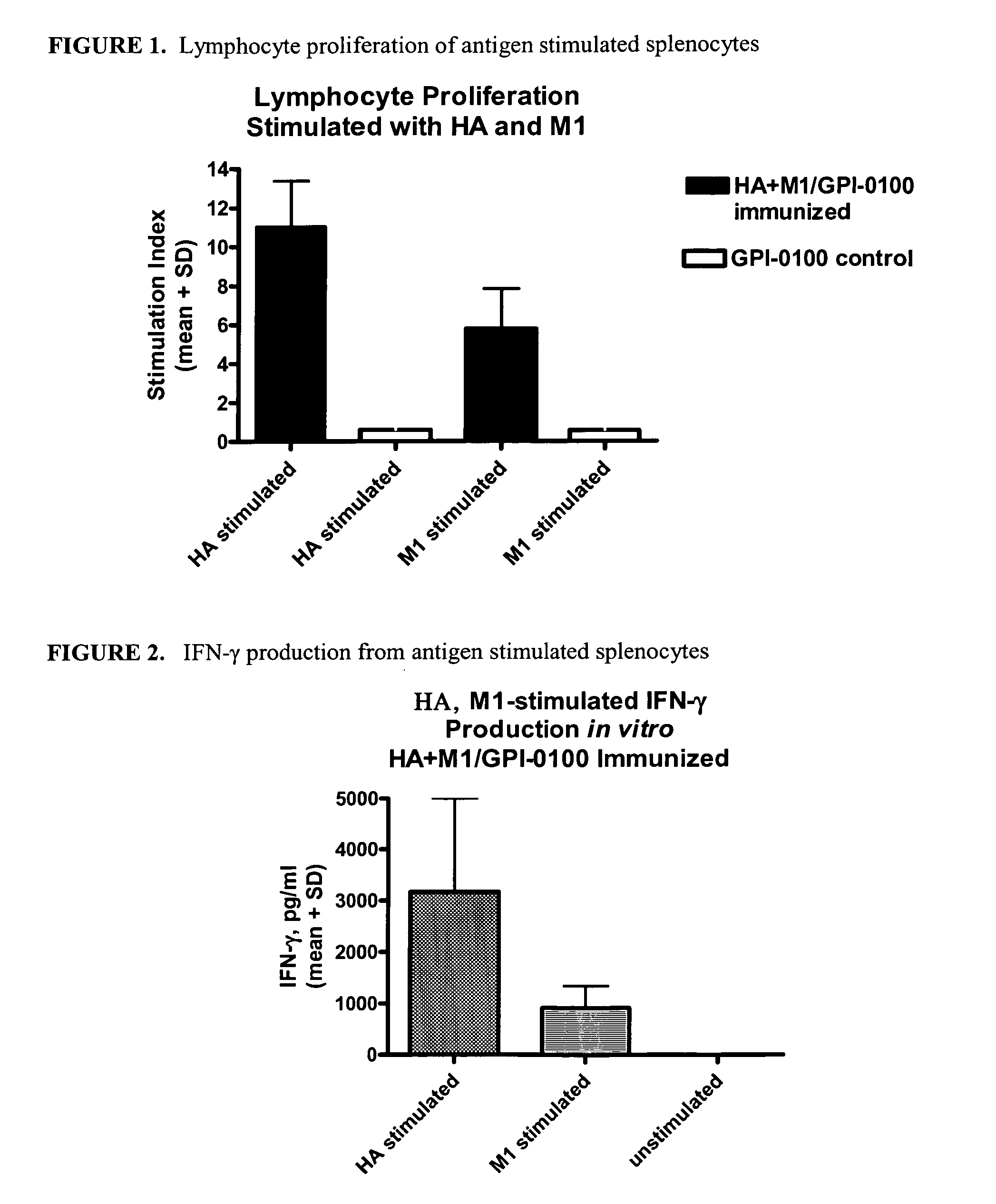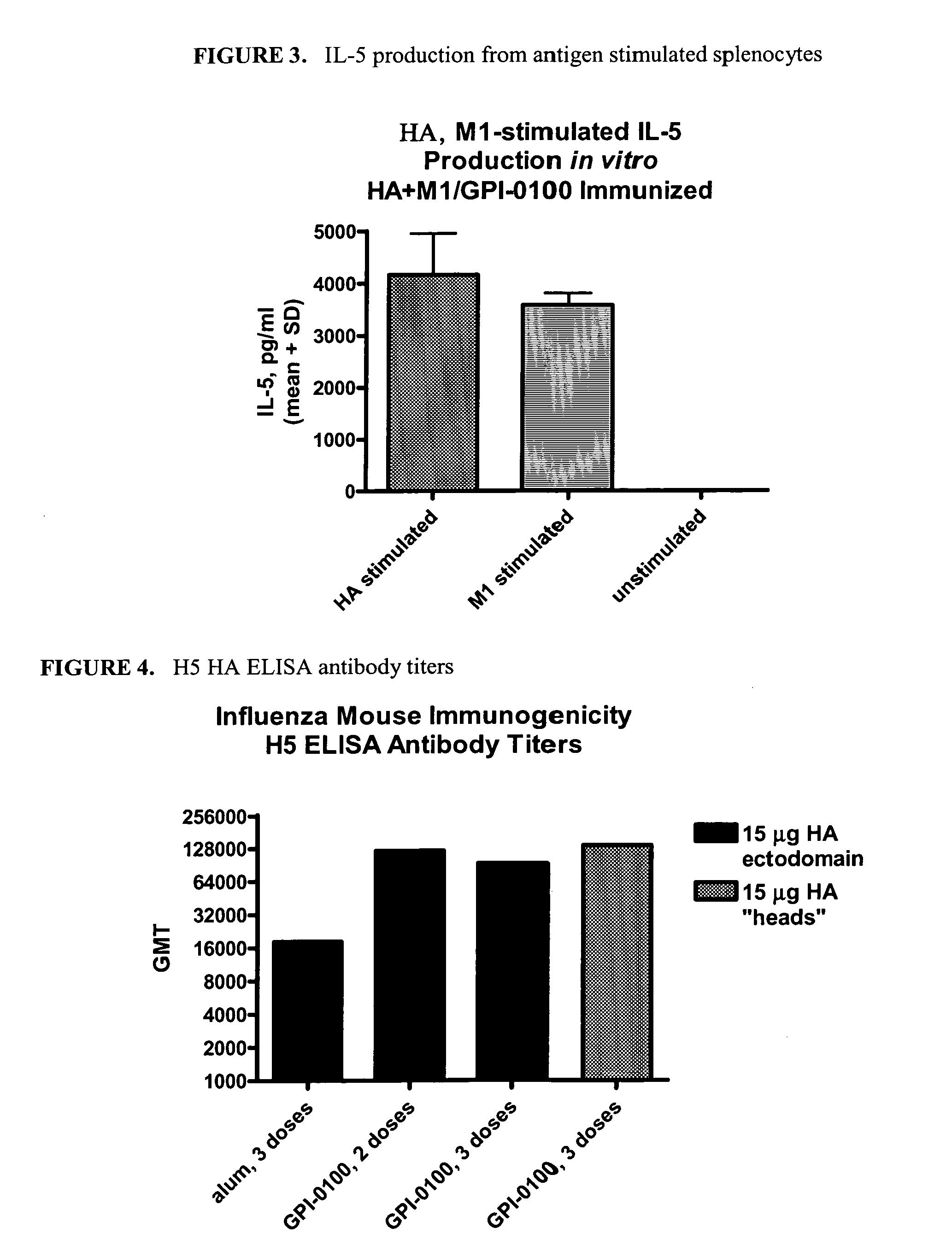Influenza recombinant subunit vaccine
a subunit vaccine and recombinant technology, applied in the field of vaccine formulations, can solve the problems of limited amount of influenza vaccine that can be produced, adverse events in those immunized with these vaccines, and differences in antigenic properties, so as to increase immunogenicity and efficacy, and strong overall antibody titers, the effect of reducing the cost of production
- Summary
- Abstract
- Description
- Claims
- Application Information
AI Technical Summary
Benefits of technology
Problems solved by technology
Method used
Image
Examples
example 1
Expression and Purification of Influenza HA Ectodomains from H5N1 and H3N2 Subtypes
[0065] A series of expression plasmids designed for the expression and selection of heterologous recombinant target proteins in cultured Drosophila cells was utilized for the work described. For details about the preparation of the expression plasmids, see U.S. Pat. Nos. 5,550,043; 5,681,713; 5,705,359; and 6,046,025, the contents of which are fully incorporated herein by reference. Specifically, the two plasmids utilized for this work are pMttbns and pCoHygro. The pMttbns expression vector contains the following elements: the Drosophila metallothionein promoter (Mtn), the human tissue plasminogen activator (tPA) signal sequence, and the SV40 early polyadenylation signal (Culp et al, Biotechnology (1991) 9:173-177). The pCoHygro plasmid provides a selectable marker for hygromycin (Van der Straten, Methods in Mol. and Cell Biol. (1989) 1:1-8). The hygromycin gene is under the transcriptional control o...
example 2
Expression and Purification of Influenza HA “Heads” from H3N2 and H5N1 Subtypes
[0079] In an effort to express a soluble form of HA capable of eliciting a more focused immune response, the ectodomain subunits described in Example 1 were further truncated at both the N- and C-terminal ends. The N- and C-terminally truncated subunits encompass the HA region known as the globular heads and are therefore referred to as HA-heads. The C-terminal truncation is at constant point for all “head” subunits. Specifically the “head” subunits are truncated at Arg329 for H3 HA-heads and Arg326 for H5 HA-heads (the number of amino acids for this purpose is based on the mature HA protein-does not include the secretion signal-as opposed to the numbering in Example 1 which is based on the full length sequence containing the secretion signal). Two N-terminal truncations were made for both H3- and H5-heads. While the numbering of the truncations between the two subtypes does not match, the truncations ar...
example 3
Expression and Purification of Influenza HA “Foldons” from H3N2 and H5N1 Subtypes
[0082] In an effort to express a soluble multimeric form of HA composed of a native-like trimeric form, a 36 amino acid sequence was fused to the C-terminus of the HA-Ecto subunits described in Example 1. Twenty nine amino acids of 36 amino acid sequence fused to the HA-Ecto subunits are derived from the bacteriophage T4 fibritin protein sequence which is refered to as the “foldon” sequence (the additional seven amino acids serve as a spacer between the HA sequence and the foldon sequence) . The foldon sequence which is located at the C-terminus of the fibritin protein naturally brings together three monomers of fibritin via non covalent bonding to form a trimeric molecule. The HA foldons were constructed by fusing the C-terminal end of the ectodomain (Gly520 for H3 and Gly521 for H5) to the 36 amino acid foldon containing sequence. The expression of this fusion of the HA ectodomain to the foldon seque...
PUM
| Property | Measurement | Unit |
|---|---|---|
| pH | aaaaa | aaaaa |
| pH | aaaaa | aaaaa |
| pH | aaaaa | aaaaa |
Abstract
Description
Claims
Application Information
 Login to View More
Login to View More - R&D
- Intellectual Property
- Life Sciences
- Materials
- Tech Scout
- Unparalleled Data Quality
- Higher Quality Content
- 60% Fewer Hallucinations
Browse by: Latest US Patents, China's latest patents, Technical Efficacy Thesaurus, Application Domain, Technology Topic, Popular Technical Reports.
© 2025 PatSnap. All rights reserved.Legal|Privacy policy|Modern Slavery Act Transparency Statement|Sitemap|About US| Contact US: help@patsnap.com



